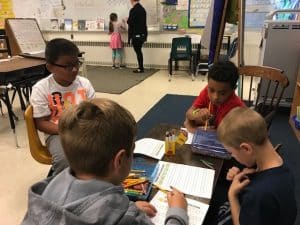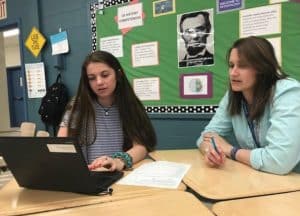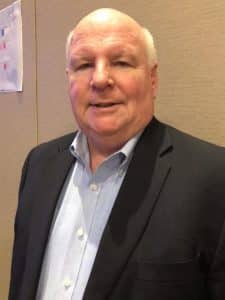New Hampshire’s Work Study Practices – Equity and Assessing For Growth
CompetencyWorks Blog
This is the third in a series of blog posts about New Hampshire’s work study practices—essential competencies such as communication, collaboration, and self-direction. Links to the others posts are below.
Equity
At the New Hampshire Learning Initiative (NHLI), we see the development of the work study practices (WSPs) as a lever for equity. Focusing on these skills for ALL learners, and how to support the growth of these skills in learners, is of paramount importance for equipping students for success. And we see that it is making a difference. As Dr. Felicia Sullivan from Jobs for the Future reports, “levels of proficiency in self-direction for low-income students and students receiving special education services are below their peers, but when they have a teacher who has received professional development for instructing and assessing self-direction, the gap is smaller” (see recent article from Dr. Sullivan about teachers as agents of change).
She went on to say that teachers historically, “whether consciously or unconsciously, assess students on WSPs”… and if teachers don’t provide instruction on WSPs, “what they are really assessing is the degree to which students’ natural abilities, prior learning experience, or family life have contributed to their development in this area.” This is why it is of utmost importance that students receive instruction on WSPs, with opportunities for students to practice developing these skills.

Teachers in our projects have indicated that they see an impact on student engagement and the essential skills and dispositions when WSPs are incorporated into classroom instruction. Out of 117 responses in a survey of teachers in four study districts, about half had embedded WSPs into their classroom instruction. Of the teachers who had embedded WSPs, 35% reported seeing changes in student attitude and 42% reported seeing changes in levels of students’ essential skills and dispositions. Given Dr. Sullivan’s findings above, this could potentially have significant effects on reducing achievement gaps. By increasing opportunities for each and every student to engage with WSPs consistently in classroom learning experiences, teachers would be helping to build the core skills for students to successfully navigate their world.
Self-Direction in Distance Learning – The New Normal
The recent 2020 COVID-19 pandemic has cast a bright light on the critical importance of self-direction, which is one of New Hampshire’s work study practices. In many of our initial conversations with teachers, administrators, and students, we discussed the importance of developing self-direction skills in school to be applied outside of school. Little did we know that this opportunity would present itself in the way it has.
Teachers across the state of New Hampshire, as well as across the country, have recognized the role self-direction is playing in a remote learning environment. Many have been surprised, too. Some of the students that teachers believed would be successful in this environment, who typically are quite self-directed in a typical school setting, have been struggling. And others, students who may typically struggle, are demonstrating self-direction like they never have.
The potential learning for everyone around self-direction from this current reality will have lasting ripple effects. For now, we are trying to capture the voices of administrators, teachers, and students in a distance learning environment to share with others, but we recognize that our approach, and students’ understanding of the “why” behind the importance of learning these skills, will be even more relevant than ever based on our learning and experiences during this turbulent time.
The System: Tying it All Together
Agency is at the heart of designing personalized learning for students. Teachers involved in our competency-based and personalized learning projects at the New Hampshire Learning Initiative all get to a point in the work where they are confronted with the importance of what it really means to personalize learning. Teachers remark on the unique ways they support individual students, and for the most part these supports are limited to resources available and the ingenuity of the individual teacher.
So often you hear people talk about teaching success habits like self-direction and collaboration, but the reality is that building these skills and student agency requires a two-way relationship between teachers and learners, not one-way teaching followed by assigning a subjective, static grade. The role of the teacher and the instructional model that frames this work is to support building connections for learners, to recognize small steps that have big meaning, to build bridges that align self-direction behaviors with the quality of the work a student produces or how they contributed to the learning within the school community. Success skills such as the WSPs are personal skills that are uniquely developed by individuals, fueled by feedback about learning that is happening in the moment, targeted to specific tasks, and connected to the progress a student has made throughout the activity, lesson, unit, or school year. The instructional model is about drawing out these skills, and the role of the educator is to help students navigate how they acquire these skills and learn to recognize them as strategic tools to leverage when needed in new learning.

Teachers will tell you that the WSPs—or the skills and dispositions for success—are always on their mind as they plan, teach, and assess students. Teachers know that these skills impact student learning and they play an important role in how students push through challenges as learners. Despite knowing how important these skills are, most teachers struggle with how to support students in developing them. There are no lesson plans for personalized learning; the objectives are not the same for all students. Simply put, these skills are different from academic skills. They need a different mindset by the teacher as well as a more responsive instructional model. There is no one goal here for the learner.
Competency-based and personalized learning redesign efforts in schools quickly expose the importance of WSPs and skills and dispositions, and the redesign unearths one of the challenges of supporting personalized learning. Traditional grading practices get in the way of the role these skills should play in the learning, hence the deliberate shift to learning progressions mentioned in our previous blog post. Often the skills are retrofitted into the grading system and treated like academic grades. While these skills should be reported, the reporting should serve as a form of feedback to inform learning and growth, and be part of self-reflection and goal setting. Students should work collaboratively with their teacher to determine what they need to work on to improve. The instructional coaching for these skills should be part of feedback to learners and dialogue for next steps. However, applying traditional grades to work study practices ruins their meaning.
Our journey in New Hampshire has been replete with learning about how to most effectively integrate essential skills and dispositions into curriculum, instruction, and assessment in meaningful ways. As described in the earlier posts in this series, the importance of metacognition has become foundational in all that we do to provide learning experiences that students can own, and our assessment practices have evolved to focus on feedback and growth, with students taking a leading role. Despite the many ways we have progressed, we recognize there are so many things still to learn, and we look forward to the coming years as our efforts to support students in their learning continue to evolve.
Learn More
- New Hampshire’s Work Study Practices – A Five-Year Journey to Understand, Share, Scale, Deepen, and Meaningfully Assess These Critical Competencies
- Recognizing the Critical Importance of Metacognition
- Framing Habits of Work and Capstone Skills in Northern Cass

Jonathan G. Vander Els directs innovative, competency-based projects for the New Hampshire Learning Initiative and is co-author of Breaking With Tradition: The Shift to Competency Based Learning in PLCs at Work (Solution Tree, 2018). Formerly, Jonathan was a principal in an elementary school recognized nationally as a model professional learning community and competency-based school. Jonathan has consulted, coached, and presented at conferences and institutes throughout the United States, and lives with his wife and three children on the NH Seacoast.
 Ellen Hume-Howard is Executive Director of the New Hampshire Learning Initiative. In this role, she supports NHLI’s vision to assist New Hampshire schools and districts to deepen their innovative practices in education and improve learning for all students. Ellen has also worked with state and national experts to design a competency assessment program using performance assessment for state accountability. Ellen currently serves as the curriculum director for the NH PACE project.
Ellen Hume-Howard is Executive Director of the New Hampshire Learning Initiative. In this role, she supports NHLI’s vision to assist New Hampshire schools and districts to deepen their innovative practices in education and improve learning for all students. Ellen has also worked with state and national experts to design a competency assessment program using performance assessment for state accountability. Ellen currently serves as the curriculum director for the NH PACE project.
 Paul Leather is Director of the Interstate Learning Community for the Center for Innovation in Education. Mr. Leather’s background and experience in Education, Counseling, and Administration in New Hampshire spans four decades. He served as the Deputy Commissioner of the Department of Education in New Hampshire for eight years, and has also served for 18 years as the Director of the Division of Career Technology and Adult Learning for the Department, overseeing numerous statewide initiatives and programs. In 1997, Mr. Leather began a journey to create a state model for competency-based education. This effort resulted in the development and implementation of the NH student mastery model now in place as part of New Hampshire’s system. More recently, he led the development of a first-in-the-nation next generation educational accountability model, called “Performance Assessment of Competency Education,” or PACE, approved as a pilot program by the US Department of Education, starting with four New Hampshire districts in March 2015. For the Center for Innovation in Education, he co-leads the 8-state Interstate Learning Community and the Intermediary Organization Learning Community with Gretchen Morgan.
Paul Leather is Director of the Interstate Learning Community for the Center for Innovation in Education. Mr. Leather’s background and experience in Education, Counseling, and Administration in New Hampshire spans four decades. He served as the Deputy Commissioner of the Department of Education in New Hampshire for eight years, and has also served for 18 years as the Director of the Division of Career Technology and Adult Learning for the Department, overseeing numerous statewide initiatives and programs. In 1997, Mr. Leather began a journey to create a state model for competency-based education. This effort resulted in the development and implementation of the NH student mastery model now in place as part of New Hampshire’s system. More recently, he led the development of a first-in-the-nation next generation educational accountability model, called “Performance Assessment of Competency Education,” or PACE, approved as a pilot program by the US Department of Education, starting with four New Hampshire districts in March 2015. For the Center for Innovation in Education, he co-leads the 8-state Interstate Learning Community and the Intermediary Organization Learning Community with Gretchen Morgan.